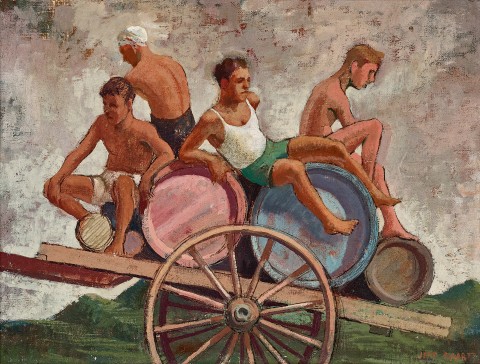WINE CARRIERS, 1950
JEFFREY SMART
oil on canvas board
33.0 x 44.0 cm
signed lower right: JEFF SMART
John Martin’s Art Gallery, Adelaide
Dr Frederick Newall, Adelaide, acquired from the above in 1951
thence by descent
Estate of the above, Sydney
Group 9, John Martin’s Art Gallery, Adelaide, 6 September 1951, cat. 40
Pearce, B., Master of Stillness: Jeffrey Smart, Wakefield Press, Adelaide, 2015 (revised and expanded edition), pp. 47 (illus.), 144
Wine Labourers and Cart, Ischia, 1949, ink and watercolour on paper, 22.0 x 27.5 cm, illus. in Capon, E. et al., Jeffrey Smart Drawing and Studies 1942 – 2001, Australian Art publishing, Melbourne, 2001, cat. 16, pp. 44, 195
We are grateful to Stephen Rogers, Archivist for the Estate of Jeffrey Smart, for his assistance with this catalogue entry.
Under a scumbled pale purple and grey sky, Jeffrey Smart’s Italian wine carriers rest their weary and suntanned bodies in a precarious balance atop barrels of locally produced wine, trundling back to the village via horse-drawn cart. Although Smart spent more than a year on the island of Ischia, off the coast of Naples between 1948–50, he painted no more than a handful of works there, finding it easier to work on paper in ink and watercolour. The origins of this painting are, in fact, found in an ink sketch from 1949, called Wine Labourers and Cart, in which we can see the barrels of famous Epomeo wine from Ischia were thankfully tied securely to the cart with a rope.
Smart travelled to Europe by cargo ship in 1948. After arriving in London, he moved to France where he was joined by his old friend from Adelaide, fellow artist Jacqueline Hick. Together they studied in Parisian art schools, La Grande Chaumière and under Fernand Léger at the Académie de Montmartre. Another South Australian artist, Michael Shannon, joined the pair, and the three of them sojourned together in an old house for an extended time on Ischia. The hedonistic lifestyle that these expatriates enjoyed on the island, while not particularly conducive to a disciplined artistic practice, would have lasting significance for Jeffrey Smart. His affinity with the Mediterranean pace of life would be later confirmed by his permanent relocation to Posticcia Nuova, the farmhouse in Arezzo where he would live for over four decades.
Warm and textured, Wine Carriers, 1950 is a carefully crafted and dramatic study of some of the young men with whom Smart shared the island. The dynamic composition of stacked circles and diagonal directing lines demonstrates the crystallisation of one of Smart’s most enduring compositional devices: the contrast of geometric structures with human figures. These men appear resigned to a life of harsh physical labour in a landscape whose sparseness is poignantly described by a low horizon and a vast, pale, featureless sky. Donald Friend, who also responded enthusiastically to the island’s attractions and joined the motley group of expatriate aesthetes, wrote of this scenery in his diaries in December 1949: ‘the setting has been unrelievedly idyllic … bleached pink and white villages in clear pale sparkling sunlight, under a pale pure sky, the air warm, dry, sharp, invigorating … and through hilly country where innumerable farms and vineyards are enclosed in rough pale grey and white stone walls ... and behind reared the jumbled crags and precipices of wild mountains and hills so patterned and textures with terraces of vineyards ... that they took on the appearance of giant fingerprints.’1
1. Hetherington, P. (ed.), The Diaries of Donald Friend: volume 3, National Library of Australia, Canberra, 2005, p. 45
LUCIE REEVES-SMITH
